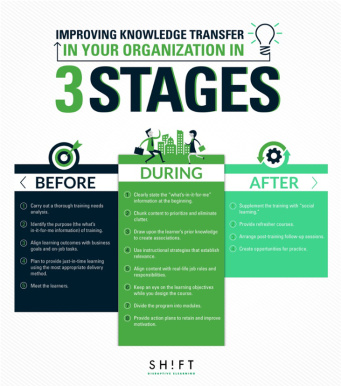 The following guest blog post is adapted from a recent blog post by Karla Gutierrez on SHIFT’s e-Learning blog.
The following guest blog post is adapted from a recent blog post by Karla Gutierrez on SHIFT’s e-Learning blog.
Learning transfer is challenging because it’s difficult to predict how each person will respond to a course.
The most powerful reason learning transfer is ineffective, as was revealed during the ATD International Conference & Exposition 2016, is that 90 percent of training is designed without a well-defined strategy that facilitates it.
As a training manager and an e-learning designer, you have to provide a comprehensive learning experience, in all stages of learning transfer: before, during and after training.
You can facilitate a glitch-free learning and transfer process by adopting these measures even before the training program starts.
Before the training
1) Carry out a thorough training needs analysis.
A comprehensive training needs analysis exercise with the trainees will help you assess what skills and knowledge they need to excel in their job responsibilities and the gaps in their existing knowledge and skill sets. The insights you gain from a training needs assessment will help you design e-learning courses with relevant content that helps learners perform well in their jobs.
2) Identify the purpose (the what’s in-it-for-me information) of training.
Identify the training goals and learning objectives before you start designing the course. This ensures all team members are on the same page, work towards a common goal and focus their efforts to achieve similar objectives.
3) Align learning outcomes with business goals and on-job tasks.
Establish a clear association between company business goals and the skills learners will develop by the time they complete the course.
4) Plan to provide just-in-time learning using the most appropriate delivery method.
To ensure your training has the maximum impact on learners, provide training just when they need it. For instance, sales reps need to access a course on the last update on a product when they are at the store in front of the client.
5) Meet the learners.
To motivate your audience of learners, managers must ensure they meet at least some of them before the training and tell them about the significance of the material. Managers, meanwhile, should realize the significance of the learning and understand how they can facilitate the learning process for their team members and create opportunities for them to apply the knowledge.

During the training
You have to ensure the e-learning course communicates meaning efficiently and creates a memorable learning experience.
1) State the “what’s-in-it-for-me” information at the beginning.
The astute learner wants to know, “What’s in it for me?” The onus is on the e-learning designer to provide a satisfactory and credible answer to this question.
2) Chunk content to prioritize and eliminate clutter.
Chunking and prioritizing content ensure your course is clutter free and relevant. Adult learners are short on time; they appreciate a course that cuts to the chase right away.
3) Draw upon the learner’s prior knowledge to create associations.
We learn best by associations. It’s easy to comprehend, remember and retain new concepts when we can connect the dots and discover underlying patterns. Try to help your learners draw upon their prior knowledge or experience to understand, discover similarities and make sense of a new concept.
4) Use instructional strategies that establish relevance.
The adult learner is motivated to apply his newly-acquired knowledge only if he or she is confident it will help him or her tackle real-life challenges.
5) Align content with real-life job roles and responsibilities.
Create scenarios or stories that demonstrate positive outcomes. Incorporate case studies and video testimonials to add legitimacy. Use these media to explain how the learner can improve his or her on-job performance, as the people in the case studies and videos have done, after taking the course.
6) Keep an eye on the learning objectives while you design the course.
Whether you’re writing a scenario or planning an activity, continue reviewing the learning objectives. This ensures your content is relevant and there is no information that does not directly relate to the overarching goals of the course.
7) Divide the program into modules.
There are several advantages of spacing out and delivering your course in modules, but most importantly it has to do with the transfer of learning. When learners return to work after completing each module, they get an opportunity to apply their newly-acquired knowledge.
8) Provide action plans to retain and improve motivation.
Help learners prepare action plans to guide them when they are back to work. These action plans lay out the guidelines that will assist learners to apply what they have learned during the training.
 After the training
After the training
The learning process continues long after the training is over.
1) Supplement the training with “social learning.”
We all learn best when we have examples to follow, friends to share our successes with, buddies to learn from and mentors in our midst. In-person meetings, chat groups, forums and videos of trainees sharing their stories are effective ways to incorporate social learning in the learning process.
2) Provide refresher courses.
Trainees often report being unable to retain key learning points after the training is over or recall these concepts when needed. A refresher course can improve recall. The course should be simple and provide just a crisp and coherent summary of the key learning concepts.
3) Arrange post-training follow-up sessions.
Reflection is one of the most efficient ways to cement the knowledge, identify gaps in training and identify the barrier(s) to a strong transfer of learning. You can send follow-up emails to trainees after about a month to reinforce key learning points. You can arrange post-training follow-up sessions to provide supplementary lessons or use these opportunities to let trainees practice their skills or discuss their experiences as they try to apply their knowledge on the job.
4) Create opportunities for practice.
Multiple research studies have emphasized the importance of repeated practice to cement one’s newly-acquired skills. Employees should be provided ample opportunities at the workplace to practice the skills they have learned from the training program.


